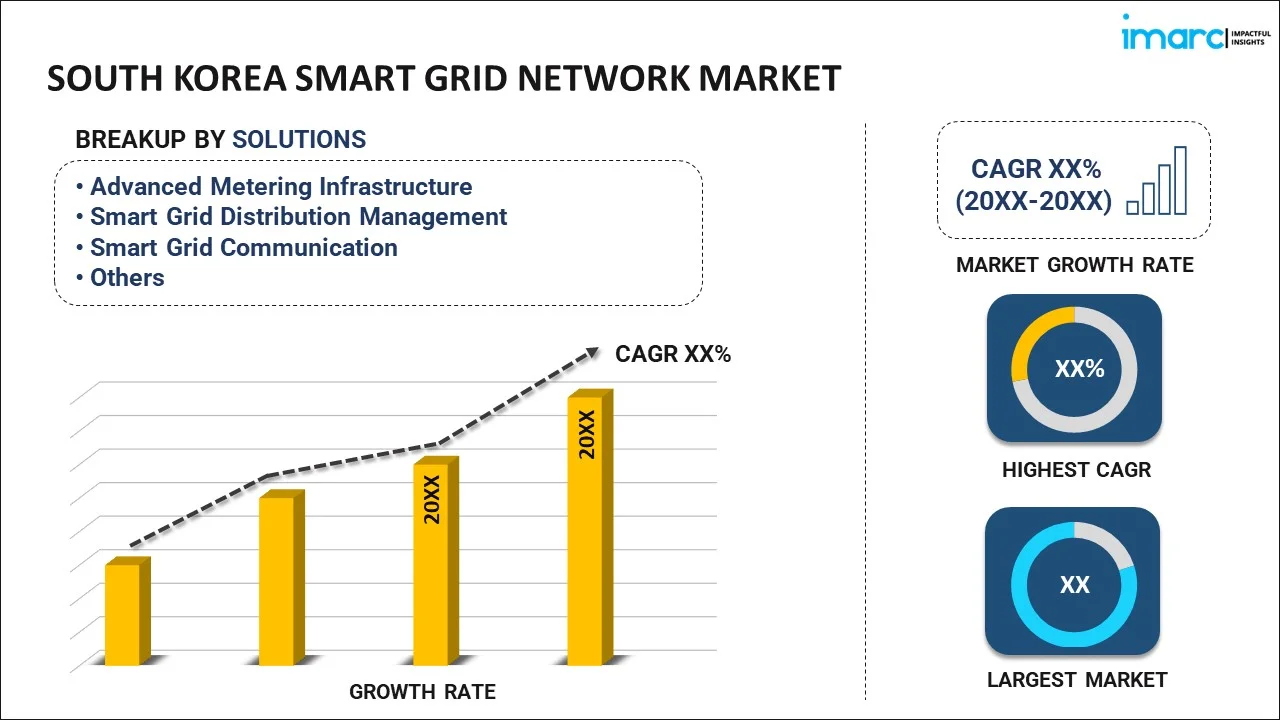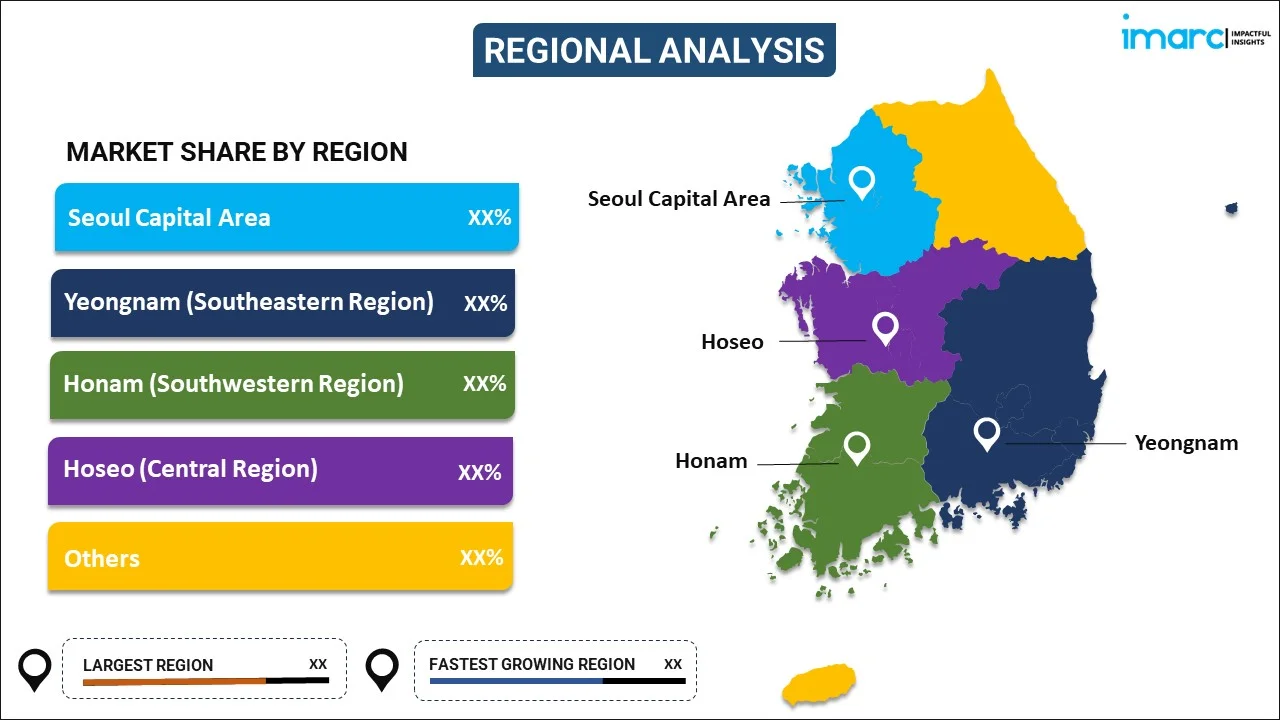
South Korea Smart Grid Network Market Report by Solution (Advanced Metering Infrastructure, Smart Grid Distribution Management, Smart Grid Communication, Grid Asset Management, Geographic Information System, Billing and Customer Information System), Services (Deployment and Integration, Consulting, Support and Maintenance), and Region 2025-2033
Market Overview:
South Korea smart grid network market size is projected to exhibit a growth rate (CAGR) of 4.09% during 2025-2033. The escalating demand for resilient and sustainable energy systems, increasing need for EV charging infrastructure, and the growing need for the modernization of aging infrastructure represent some of the key factors driving the market.
|
Report Attribute
|
Key Statistics
|
|---|---|
|
Base Year
|
2024 |
|
Forecast Years
|
2025-2033 |
|
Historical Years
|
2019-2024
|
| Market Growth Rate (2025-2033) | 4.09% |
A smart grid network is a sophisticated and modernized electrical distribution system that relies on advanced technology to enhance the efficiency, reliability, and sustainability of electricity generation, transmission, and distribution. It integrates two-way communication between various components of the electrical system and enables real-time monitoring and control. It incorporates advanced sensors and automation systems that constantly monitor electricity flow, voltage levels, and the working conditions of equipment, such as transformers and substations. It allows utilities to optimize power delivery and individuals to make informed decisions about their energy usage. It contributes to lower greenhouse gas emissions and a more environment friendly energy system and promotes energy conservation and sustainability. Besides this, it is equipped with robust cybersecurity measures to protect against potential threats and attacks.
South Korea Smart Grid Network Market Trends:
The increasing power consumption and the growing focus on energy conservation represent one of the key factors positively influencing the market in South Korea. Smart meters provide real-time data, allowing individuals to monitor and adjust their electricity usage more effectively. Additionally, the escalating demand for resilient and sustainable energy systems to withstand frequent extreme weather events is creating a positive outlook for the market. Smart grids can enhance stability, reduce energy waste, and facilitate the integration of renewable energy sources, aligning perfectly with sustainability goals. Along with this, rising sales of electric vehicles (EVs) and the increasing need for charging infrastructures are impelling the market growth. Furthermore, the expansion of renewable energy capacity, particularly solar and wind power, is strengthening the growth of the market in the country. Moreover, the robust technology and manufacturing sector of South Korea is offering a favorable market outlook. The country is home to several leading electronics and technology companies with expertise in developing components and systems for smart grids, which fosters innovation and enables cost-effective production of smart grid equipment, making these solutions more accessible to utilities and individuals. Besides this, governing authorities of the country are introducing several policies, such as the Renewable Portfolio Standard (RPS) and the Green New Deal, to promote renewable energy and energy efficiency, which is driving the demand for smart grid solutions. In addition, governing agencies are imposing stringent cybersecurity regulations and standards to safeguard smart grid infrastructure. Furthermore, the rising need for the modernization of aging infrastructure is stimulating the market growth. Smart grid technology allows for the gradual replacement and upgrade of infrastructure components, such as transformers and substations, without involving large-scale disruptive projects.
South Korea Smart Grid Network Market Segmentation:
IMARC Group provides an analysis of the key trends in each segment of the market, along with forecasts at the country level for 2025-2033. Our report has categorized the market based on solution and services.
Solution Insights:

- Advanced Metering Infrastructure
- Smart Grid Distribution Management
- Smart Grid Communication
- Grid Asset Management
- Geographic Information System
- Billing and Customer Information System
A detailed breakup and analysis of the market based on the solution have also been provided in the report. This includes advanced metering infrastructure, smart grid distribution management, smart grid communication, grid asset management, geographic information system, and billing and customer information system.
Services Insights:
- Deployment and Integration
- Consulting
- Support and Maintenance
A detailed breakup and analysis of the market based on the services have also been provided in the report. This includes deployment and integration, consulting, support and maintenance.
Regional Insights:

- Seoul Capital Area
- Yeongnam (Southeastern Region)
- Honam (Southwestern Region)
- Hoseo (Central Region)
- Others
The report has also provided a comprehensive analysis of all the major regional markets, which include Seoul Capital Area, Yeongnam (Southeastern Region), Honam (Southwestern Region), Hoseo (Central Region), and Others.
Competitive Landscape:
The market research report has also provided a comprehensive analysis of the competitive landscape in the market. Competitive analysis such as market structure, key player positioning, top winning strategies, competitive dashboard, and company evaluation quadrant has been covered in the report. Also, detailed profiles of all major companies have been provided.
South Korea Smart Grid Network Market Report Coverage:
| Report Features | Details |
|---|---|
| Base Year of the Analysis | 2024 |
| Historical Period | 2019-2024 |
| Forecast Period | 2025-2033 |
| Units | Million USD |
| Scope of the Report | Exploration of Historical Trends and Market Outlook, Industry Catalysts and Challenges, Segment-Wise Historical and Future Market Assessment:
|
| Solutions Covered | Advanced Metering Infrastructure, Smart Grid Distribution Management, Smart Grid Communication, Grid Asset Management, Geographic Information System, Billing and Customer Information System |
| Services Covered | Deployment and Integration, Consulting, Support and Maintenance |
| Regions Covered | Seoul Capital Area, Yeongnam (Southeastern Region), Honam (Southwestern Region), Hoseo (Central Region), Others |
| Customization Scope | 10% Free Customization |
| Post-Sale Analyst Support | 10-12 Weeks |
| Delivery Format | PDF and Excel through Email (We can also provide the editable version of the report in PPT/Word format on special request) |
Key Questions Answered in This Report:
- How has the South Korea smart grid network market performed so far and how will it perform in the coming years?
- What has been the impact of COVID-19 on the South Korea smart grid network market?
- What is the breakup of the South Korea smart grid network market on the basis of solution?
- What is the breakup of the South Korea smart grid network market on the basis of services?
- What are the various stages in the value chain of the South Korea smart grid network market?
- What are the key driving factors and challenges in the South Korea smart grid network?
- What is the structure of the South Korea smart grid network market and who are the key players?
- What is the degree of competition in the South Korea smart grid network market?
Key Benefits for Stakeholders:
- IMARC’s industry report offers a comprehensive quantitative analysis of various market segments, historical and current market trends, market forecasts, and dynamics of the South Korea smart grid network market from 2019-2033.
- The research report provides the latest information on the market drivers, challenges, and opportunities in the South Korea smart grid network market.
- Porter's five forces analysis assist stakeholders in assessing the impact of new entrants, competitive rivalry, supplier power, buyer power, and the threat of substitution. It helps stakeholders to analyze the level of competition within the South Korea smart grid network industry and its attractiveness.
- Competitive landscape allows stakeholders to understand their competitive environment and provides an insight into the current positions of key players in the market.
Need more help?
- Speak to our experienced analysts for insights on the current market scenarios.
- Include additional segments and countries to customize the report as per your requirement.
- Gain an unparalleled competitive advantage in your domain by understanding how to utilize the report and positively impacting your operations and revenue.
- For further assistance, please connect with our analysts.
 Request Customization
Request Customization
 Speak to an Analyst
Speak to an Analyst
 Request Brochure
Request Brochure
 Inquire Before Buying
Inquire Before Buying




.webp)




.webp)












